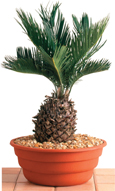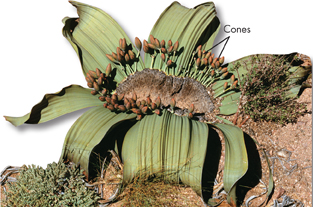There are four groups of gymnosperms, representing about 800 species in total.
CONIFERS
Conifers are by far the most diverse group of living gymnosperms, represented by nearly 700 species worldwide. They include the common pine, spruce, fir, and redwood trees that make up a large share of the forests in the temperate regions of the world. Conifers have enormous economic importance. Their wood is used for residential building, to manufacture paper, and as a source of heat. Compounds from their resins are used for a variety of industrial purposes.

Most conifers retain their leaves year-round.
CYCADS
Cycads (SY kads) are beautiful palmlike plants that have large cones. Cycads first appeared in the fossil record during the Triassic Period, 225 million years ago. Huge forests of cycads thrived when dinosaurs roamed Earth. Today, only nine genera of cycads exist. Cycads can be found growing naturally in tropical and subtropical places such as Mexico, the West Indies, Florida, and parts of Asia, Africa, and Australia.

A Sago Palm, Cycas revoluta
GINKGOES
Ginkgoes (GING kohs) were common when dinosaurs were alive, but today the group contains only one species, Ginkgo biloba. The living Ginkgo species looks similar to its fossil ancestors—in fact, G. biloba may be one of the oldest seed plant species alive today.

Ginkgoes are often planted in urban settings, where their toughness and resistance to air pollution make them popular shade trees.
GNETOPHYTES
About 70 present-day species of gnetophytes (NET oh fyts) are known, placed in just three genera. The reproductive scales of these plants are clustered in cones.

Welwitschia mirabilis, an inhabitant of the Namibian desert in southwestern Africa, is one of the most remarkable gnetophytes. Its huge leathery leaves grow continuously and spread across the ground.
Table of Contents
- Formulas and Equations
- Applying Formulas and Equations
- Mean, Median, and Mode
- Estimation
- Using Measurements in Calculations
- Effects of Measurement Errors
- Accuracy
- Precision
- Comparing Accuracy and Precision
- Significant Figures
- Calculating With Significant Figures
- Scientific Notation
- Calculating With Scientific Notation
- Dimensional Analysis
- Applying Dimensional Analysis




